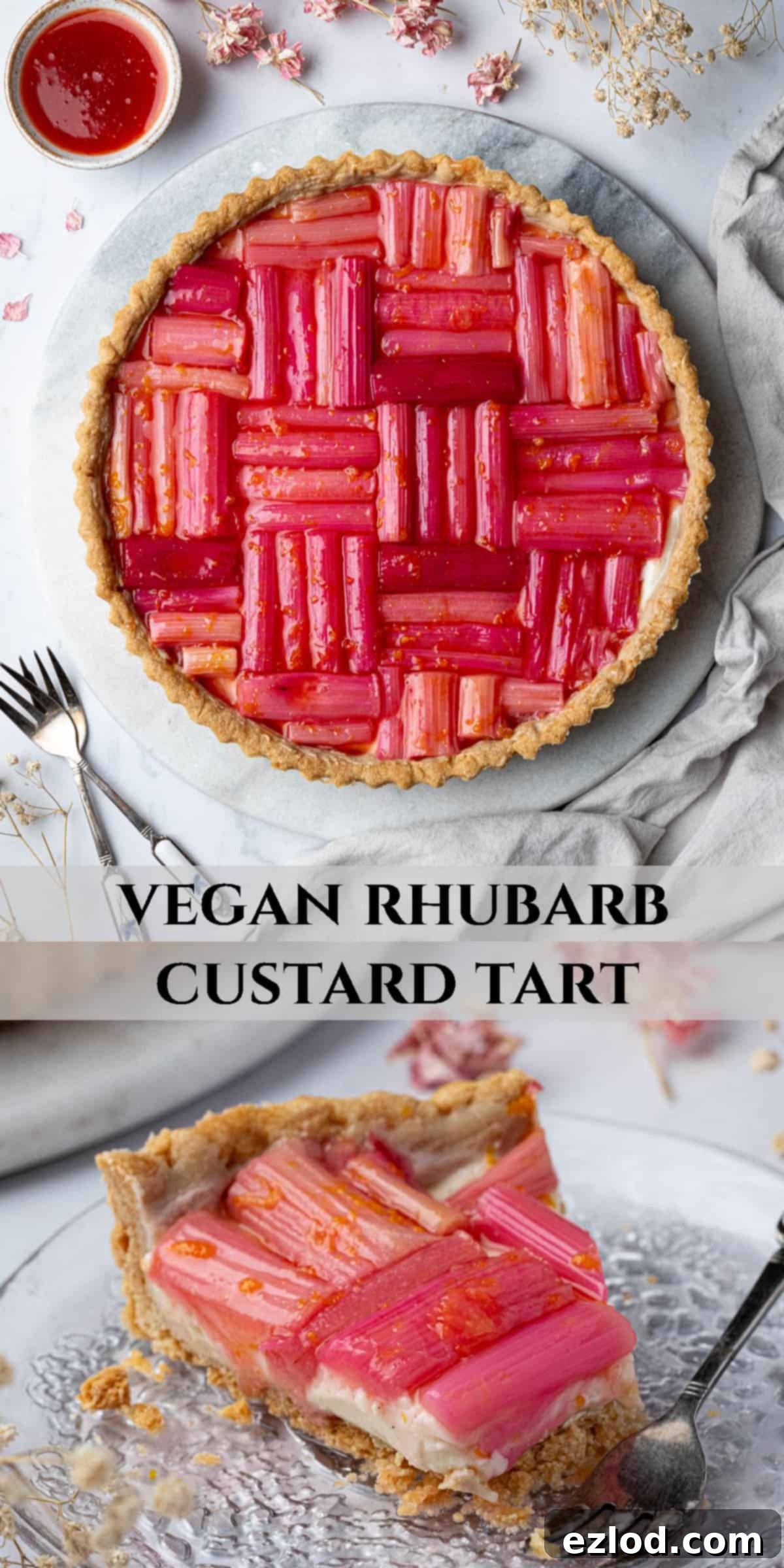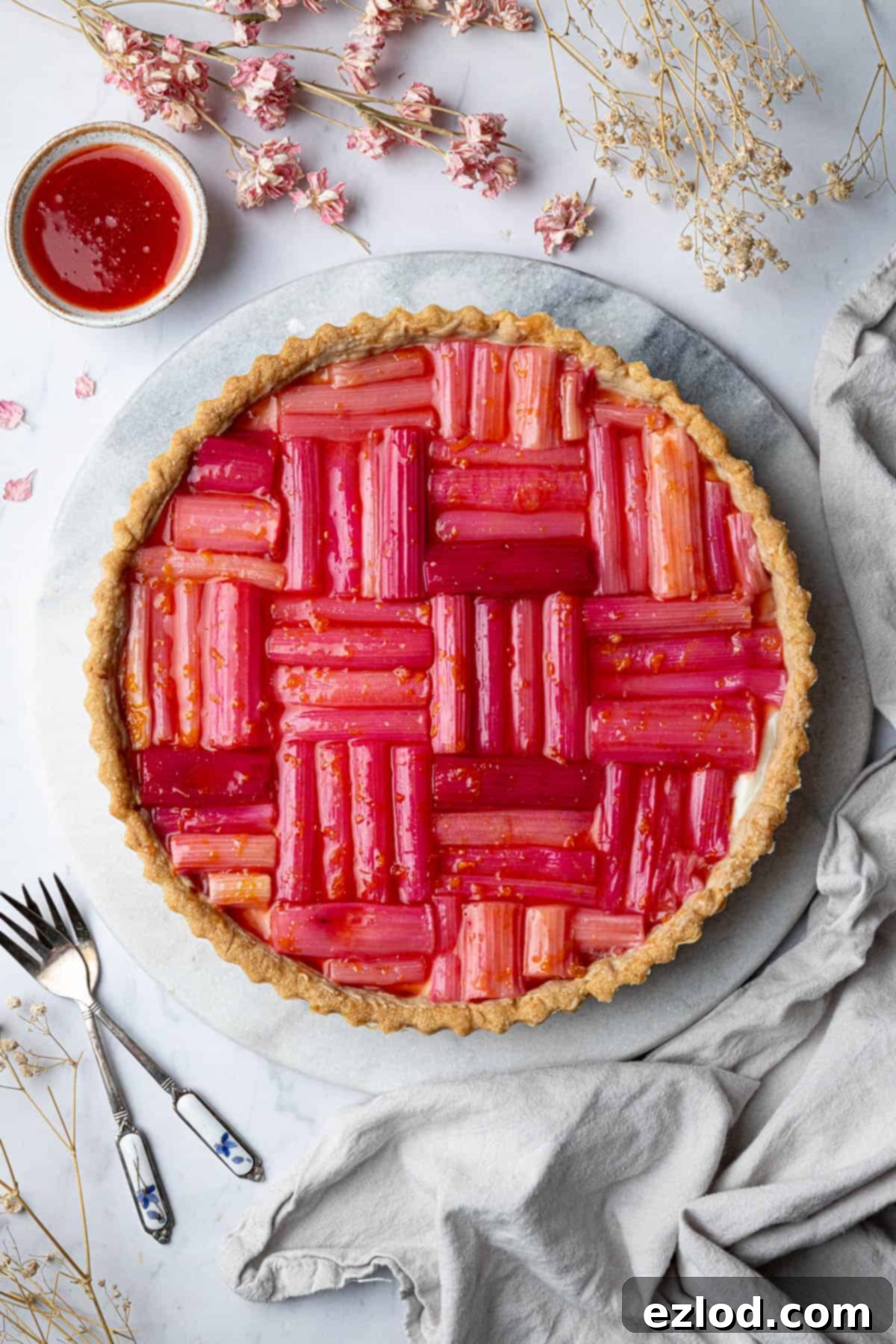The Ultimate Vegan Rhubarb Tart: A Tangy & Creamy Spring Dessert
Welcome to the ultimate guide for creating an absolutely show-stopping vegan rhubarb tart! This exquisite dessert perfectly marries a crisp, golden shortcrust pastry base with a lusciously creamy vegan vanilla pastry cream and a vibrant layer of tangy, perfectly roasted rhubarb. It’s a delightful plant-based twist on the beloved classic rhubarb and custard tart, designed to impress with both its stunning appearance and irresistible flavor.
While this tart looks incredibly elegant, it’s surprisingly accessible to make, delivering an unforgettable taste that will have everyone asking for more. As rhubarb season arrives, there’s no better way to celebrate its unique sweet-tart flavor than with this beautiful, easy-to-make vegan treat. Whether you’re a seasoned vegan baker or simply looking for a fantastic spring dessert recipe, this tart promises to be a new favorite.
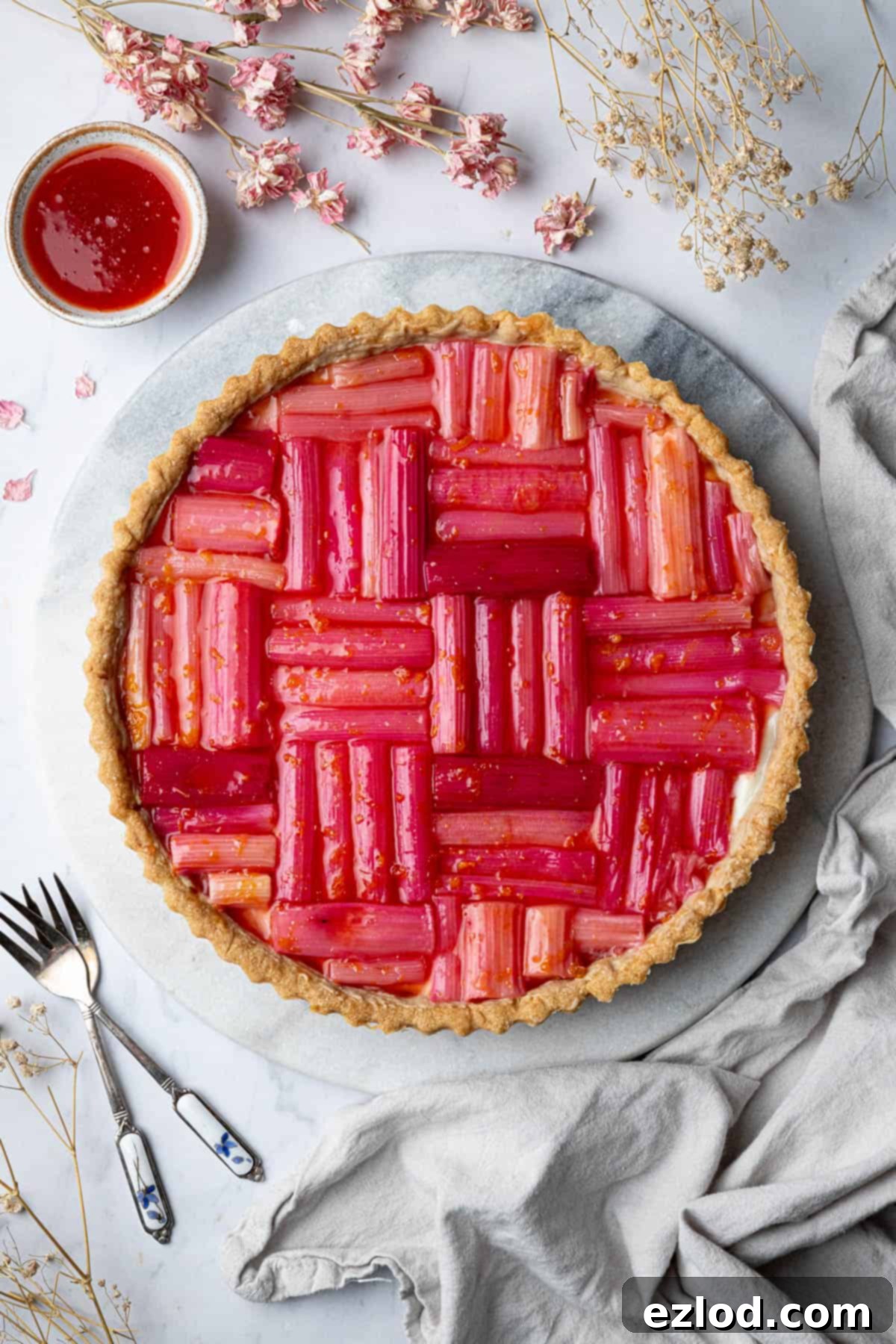
Why You’ll Fall in Love with This Vegan Rhubarb Tart
The combination of rhubarb and custard is a timeless pairing, celebrated for its exquisite balance of flavors. The bright, zesty tang of rhubarb perfectly complements the sweet, rich, and velvety texture of a classic custard. In this vegan rendition, we’ve elevated that traditional harmony with our exceptional vegan vanilla pastry cream. This creamy, dairy-free alternative not only replicates the luxurious mouthfeel of traditional custard but also enhances the overall profile of the tart, making it utterly addictive.
Beyond the incredible flavor, this tart boasts a stunning visual appeal, especially when adorned with artfully arranged rhubarb. While I’ve opted for a decorative presentation, rest assured that even a simple mound of roasted rhubarb atop the pastry cream will look fantastic. Feel free to experiment with your own designs or keep it beautifully rustic. Its gorgeous pink hue makes it a perfect centerpiece for special occasions like Easter brunches, Mother’s Day celebrations, or any festive gathering during the spring and summer months.
Key Ingredients for a Perfect Vegan Rhubarb Tart
Crafting this delightful vegan rhubarb tart relies on a few carefully selected ingredients, each playing a crucial role in achieving the perfect balance of flavor and texture. Here’s a detailed look at what you’ll need:
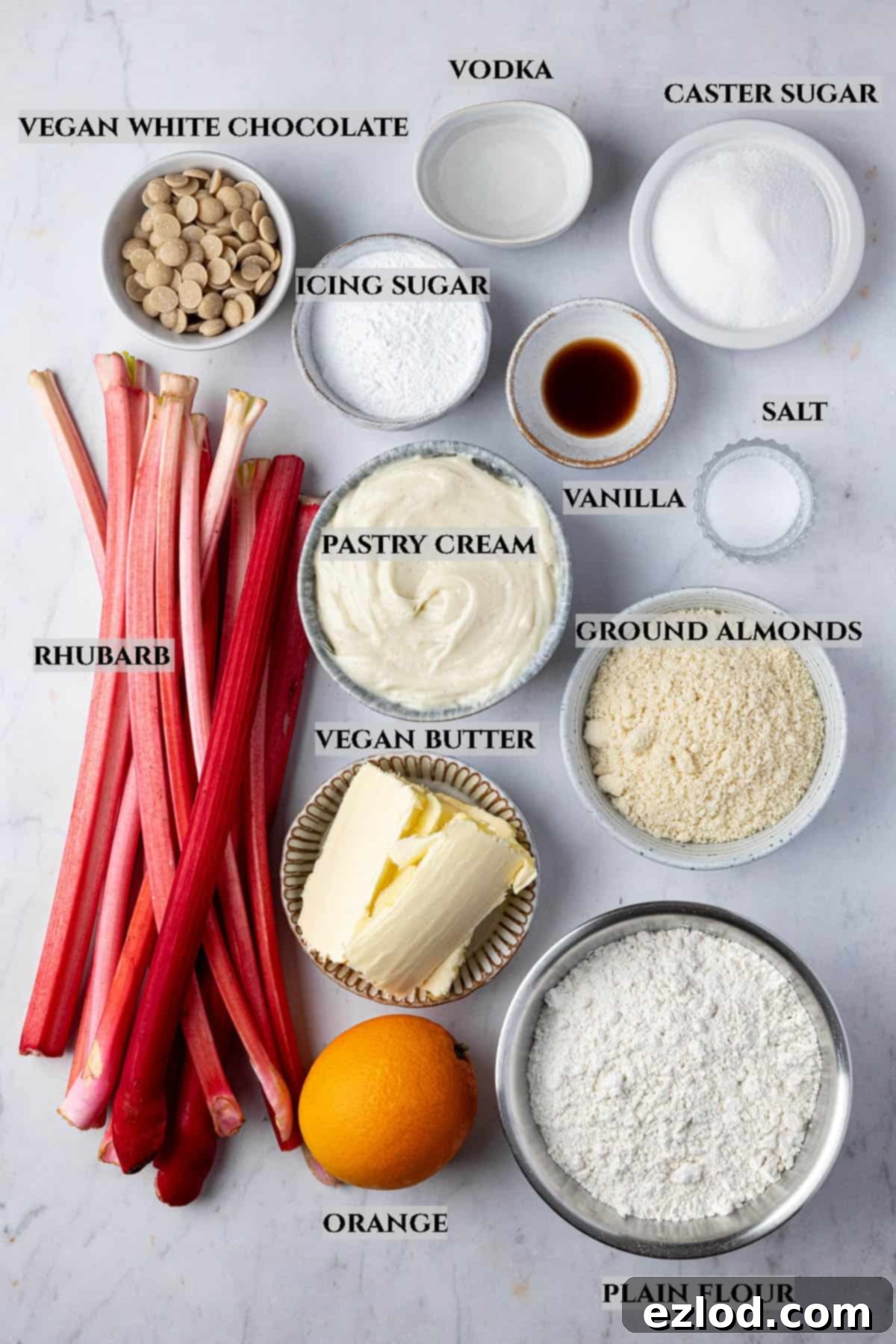
Rhubarb: The Star of the Show
- Forced Rhubarb: For the most beautiful pink color and a sweeter, more tender stalk, I highly recommend using forced rhubarb. It’s harvested earlier in the season and has a less intense tartness, making it ideal for desserts. If forced rhubarb isn’t available, regular field rhubarb will also work wonderfully; just be aware its color might be greener and its flavor more tart, so you might want to add a touch more sugar.
The Creamy Heart: Vegan Pastry Cream
- Vegan Pastry Cream: This is the soul of the tart! You’ll need one batch of my specially developed vegan vanilla pastry cream, prepared in advance and thoroughly chilled. The chilling step is essential as it allows the cream to firm up to the perfect consistency for the tart. Its rich, velvety texture and fragrant vanilla notes are what truly elevate this dessert from good to extraordinary.
The Secret to a Crisp Crust: Vegan White Chocolate
- Vegan White Chocolate: While optional, I strongly recommend incorporating this step. Brushing the inside of your baked shortcrust pastry case with a thin layer of melted vegan white chocolate acts as a moisture barrier. This prevents the creamy filling from seeping into the pastry, ensuring your tart base remains wonderfully crisp for longer. Look for high-quality oat milk or rice milk-based vegan white chocolate chips or bars, available in many health food stores and increasingly in major supermarkets. I personally source mine from here.
A Citrusy Brightness: Orange
- Orange: Roasting the rhubarb with fresh orange zest and juice infuses it with a bright, citrusy aroma and flavor. This subtle addition beautifully enhances the rhubarb’s natural tanginess, adding depth and complexity that sets this tart apart.
The Perfect Pastry Base: Vegan Butter & Flour
- Vegan Block Butter: For a truly flaky and crisp shortcrust pastry, using a solid block-style vegan butter or margarine is crucial. Avoid spreadable varieties that come in tubs, as their higher water content will result in a softer, less desirable pastry texture. Brands like Naturli Vegan Block or Flora Plant Butter are excellent choices. Ensure it’s very cold and diced before use.
- Plain Flour (All-Purpose Flour): Standard plain (all-purpose) flour is best for this pastry recipe, providing the ideal structure without making the crust too heavy or tough.
The Crisp Pastry Trick: Vodka
- Vodka: My not-so-secret weapon for ultra-crispy pastry! The science behind it is simple: vodka has a lower water percentage than plain water. When you use a small amount of vodka to bind the pastry, the alcohol evaporates much faster during baking, leaving behind a flakier, crispier crust. Don’t worry, you won’t taste it at all! If you prefer not to use alcohol, cold water works perfectly fine as a substitute, though the crispness might be slightly less pronounced. It’s definitely worth a try if you have a bottle lurking in your cupboard!
Sweetness & Texture: Sugar & Ground Almonds
- Sugar: I use icing (powdered) sugar in the pastry for a finer texture and quick dissolving, and caster or granulated sugar for the rhubarb. These specific types are chosen for their properties in each component; for the best results, avoid swapping them for other sugar varieties like brown sugar or liquid sweeteners.
- Ground Almonds: Adding ground almonds to the pastry not only imparts a delightful nutty flavor but also contributes to a wonderfully crisp and tender texture. If you have an almond allergy or simply prefer, you can substitute them with an equal weight of plain flour.
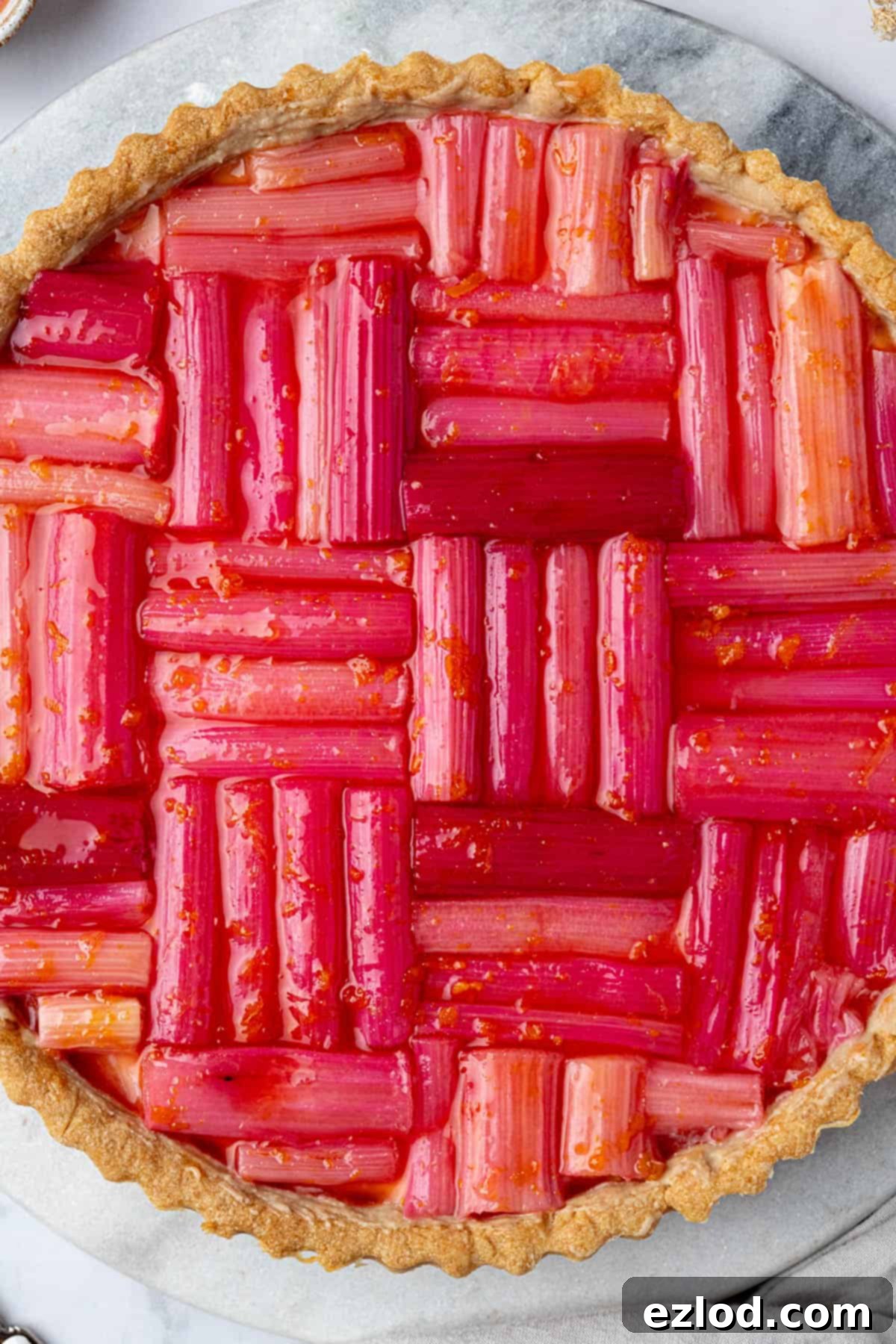
How To Make This Amazing Vegan Rhubarb Tart: Step-by-Step Guide
(For precise measurements and detailed instructions, please refer to the comprehensive recipe card located at the bottom of this page.)
This tart is assembled in stages, ensuring each component is perfect before coming together for a truly magnificent dessert. Remember, preparation is key, so make sure your vegan pastry cream is already made and chilled!
Step 1: Prepare the Crisp Shortcrust Pastry
In a large mixing bowl, combine the plain flour, ground almonds, icing sugar, and a pinch of salt. Whisk them together thoroughly. Next, add the very cold, diced vegan block butter. Using your fingertips, gently rub the butter into the dry ingredients until the mixture resembles fine breadcrumbs, with no visible lumps of butter remaining. Now, introduce the cold vodka (or water) and mix until just combined. Gradually add small amounts of additional cold water, a teaspoon at a time, until the pastry comes together into a cohesive ball. Be careful not to overwork it. Form the pastry into a flat disc, wrap it tightly in cling film, and refrigerate for at least one hour. This chilling period is crucial for a tender, easy-to-handle pastry.
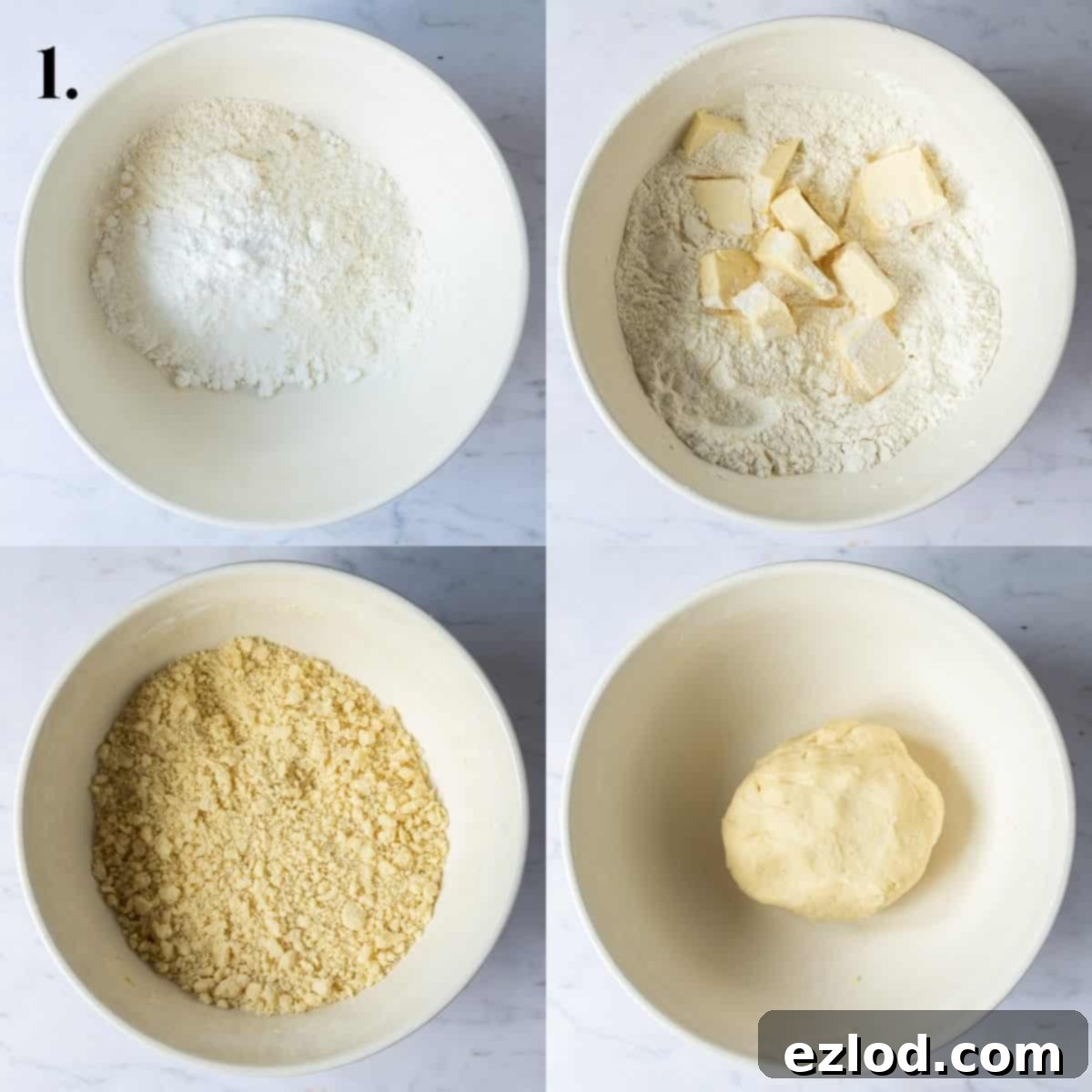
Step 2: Line the Tart Tin
Once chilled, remove the pastry from the fridge. On a lightly floured surface, roll it out into a circle large enough to comfortably line a 23-25cm (9-10 inch) loose-bottomed tart tin. Carefully transfer the pastry to the tin, gently pressing it into all the corners and up the sides. Trim any excess pastry from the edges. Prick the base of the pastry shell all over with a fork – this helps prevent it from puffing up during baking. Place the lined tart tin into the freezer for 20 minutes to solidify the pastry. This freezing step is vital for a super crisp, non-shrinking crust.
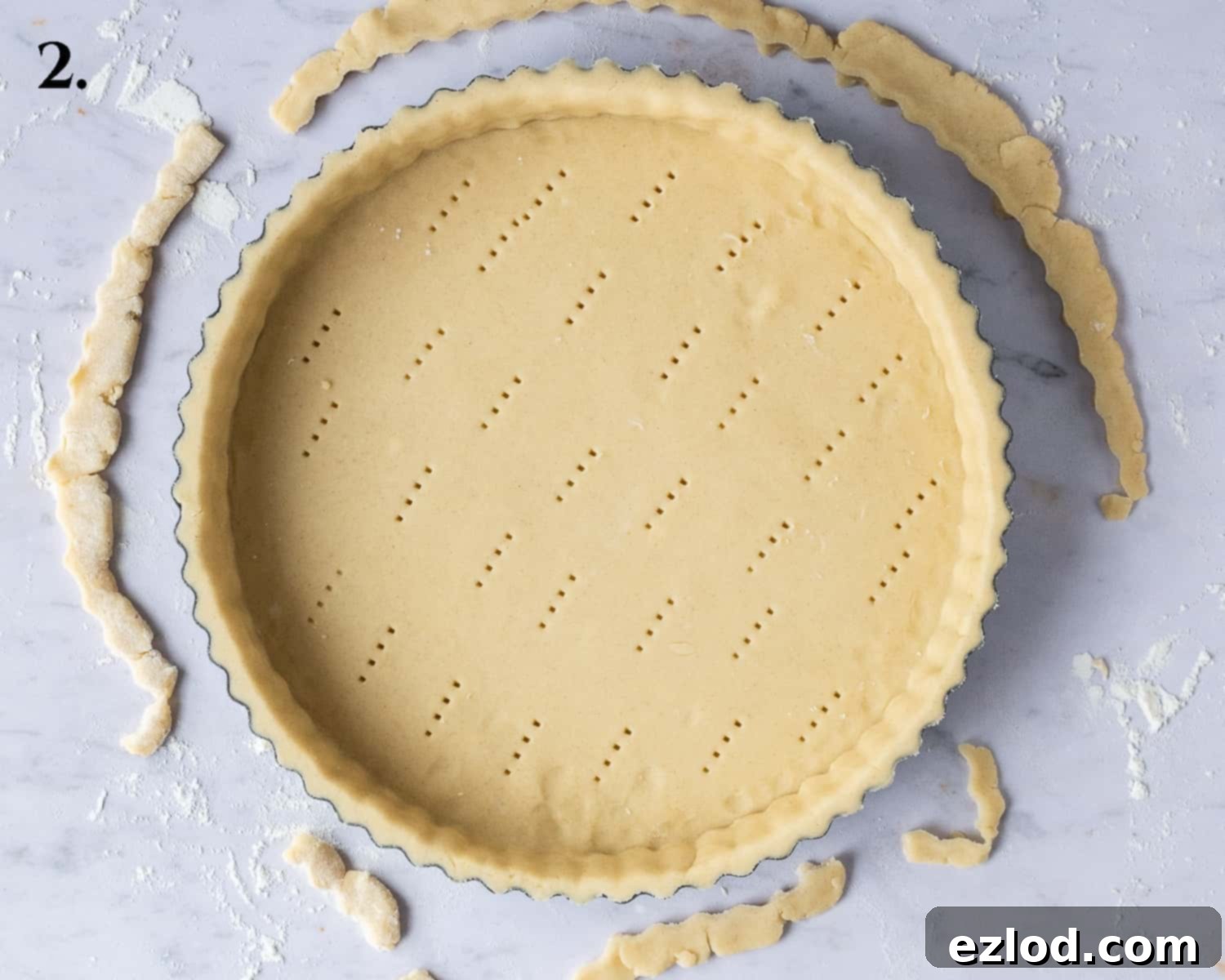
Step 3: Prepare for Blind Baking
While the pastry is chilling, preheat your oven to 180°C/160°C fan/350°F/gas mark 4. Remove the frozen tart shell from the freezer. Line the pastry case with baking parchment, ensuring it presses snugly into the corners and covers the sides. Fill the parchment-lined shell with baking beans or dried rice. These weights will prevent the pastry from bubbling up or the sides from collapsing during blind baking.
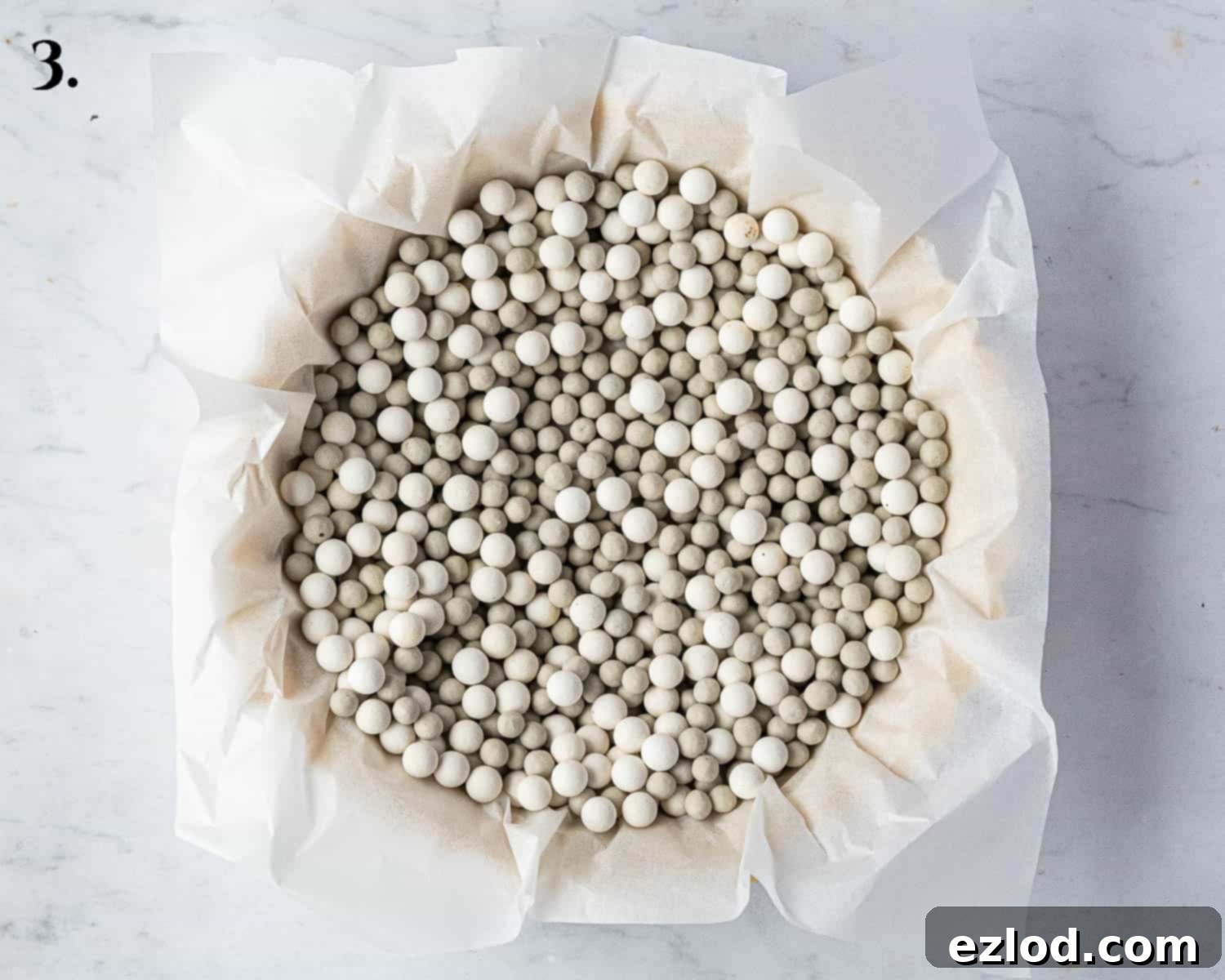
Step 4: Blind Bake the Pastry
Bake the weighted pastry case for 25 minutes. After this initial bake, carefully remove the baking parchment and the baking beans. Return the tart shell to the oven for an additional 15-20 minutes, or until the pastry is beautifully golden brown and fully cooked through. This second bake ensures a perfectly crisp and sturdy base. Once baked, set the pastry case aside to cool completely before proceeding.
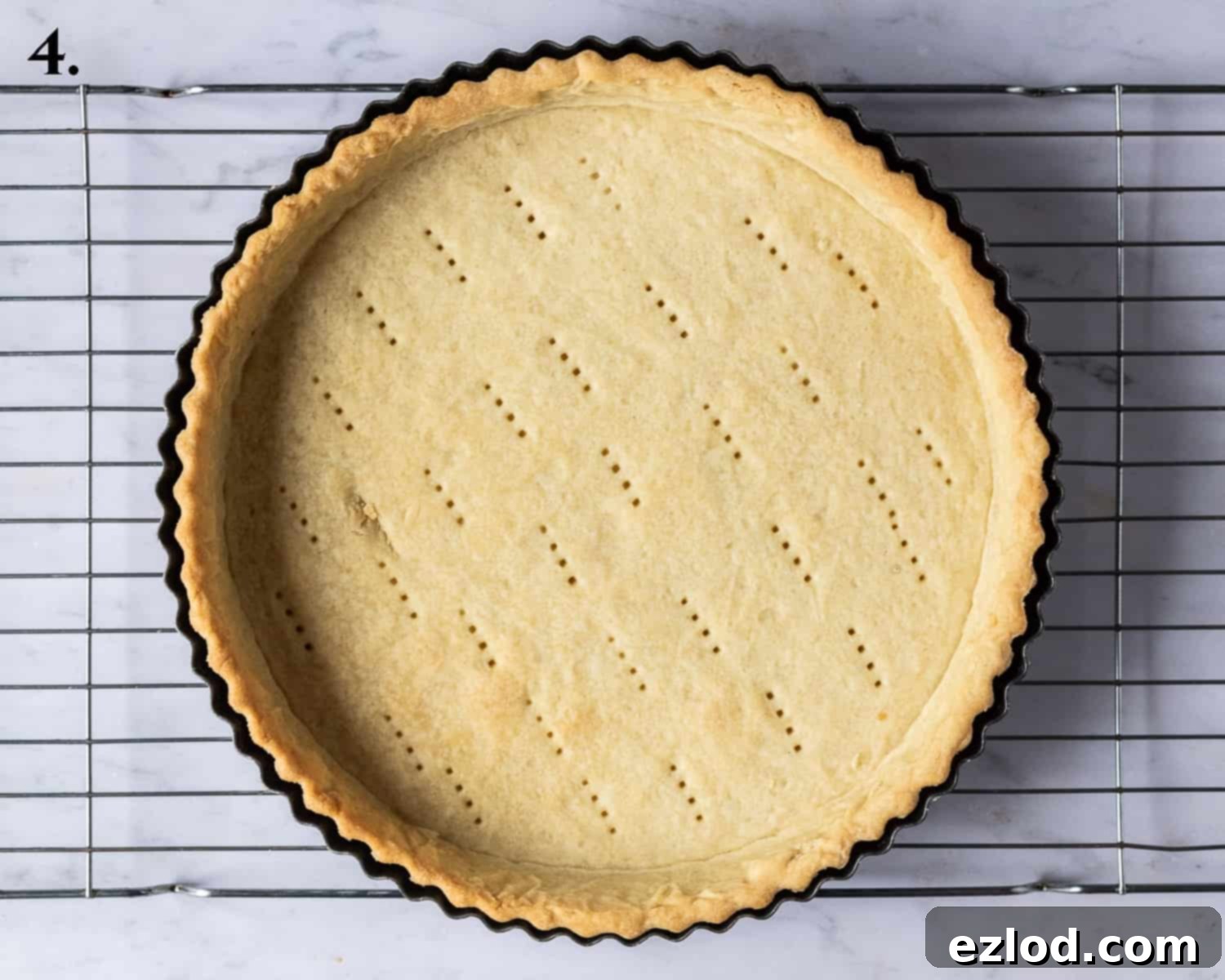
Step 5: Roast the Tangy Rhubarb
While the pastry cools, prepare your rhubarb. Slice the rhubarb stalks into approximately 5cm (2-inch) pieces. Lay these pieces in a single layer in a roasting tin. Sprinkle evenly with caster or granulated sugar, then add the finely grated zest of one orange. Pour over the orange juice and vanilla extract. Gently toss to combine. Roast in the preheated oven for 12-15 minutes, or until the rhubarb is tender but still retains its shape. It should not be mushy. Remove from the oven and let it cool completely. This gentle roasting method enhances its flavor and makes it perfect for decorating.
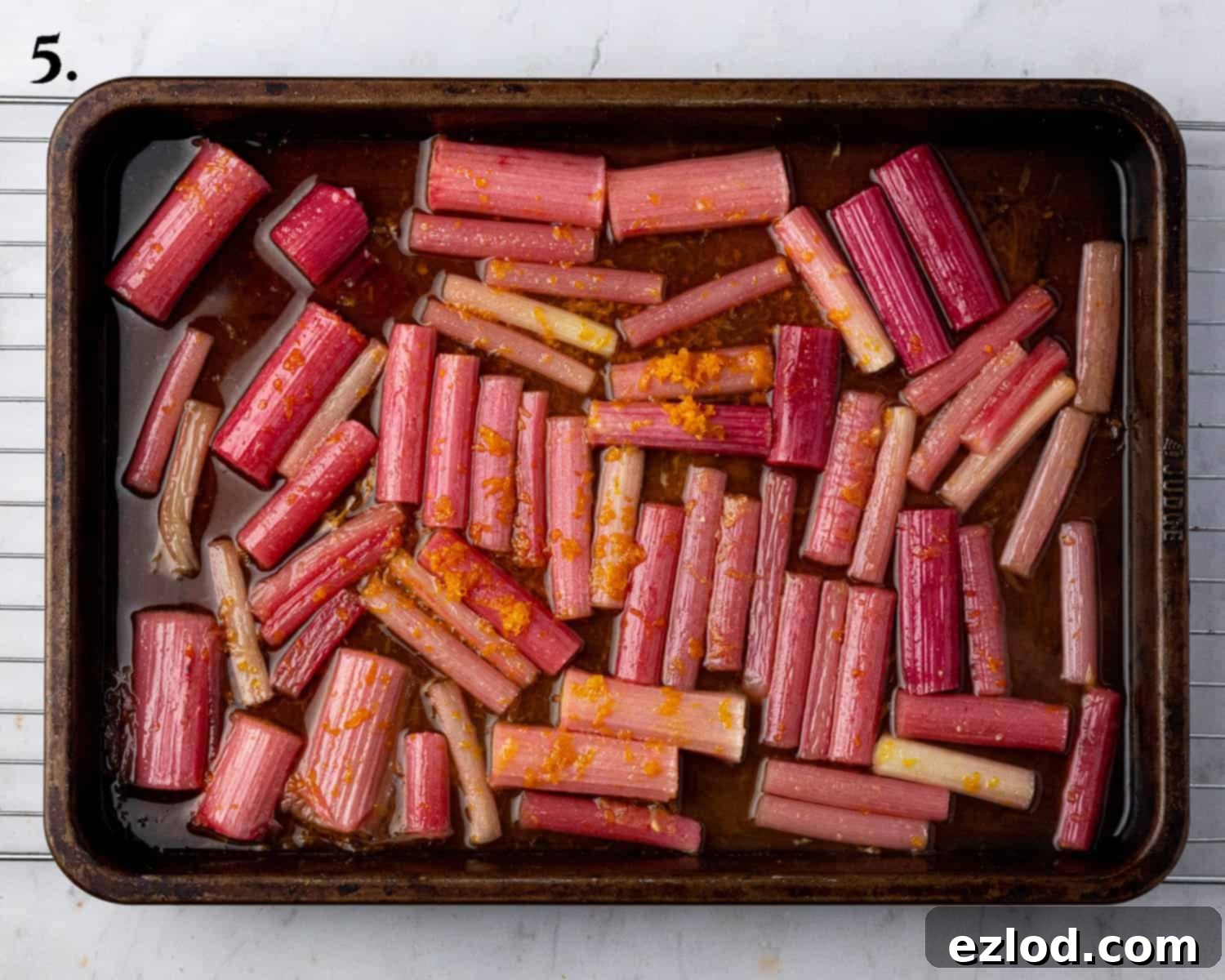
Step 6: Create a Moisture Barrier
Once the pastry case has completely cooled, melt the vegan white chocolate. Using a pastry brush, gently coat the entire inside surface of the baked pastry case with the melted chocolate. This thin layer will harden and act as a barrier, protecting the pastry from any moisture in the cream filling and ensuring your crust remains crisp. Set aside until the chocolate has fully set.
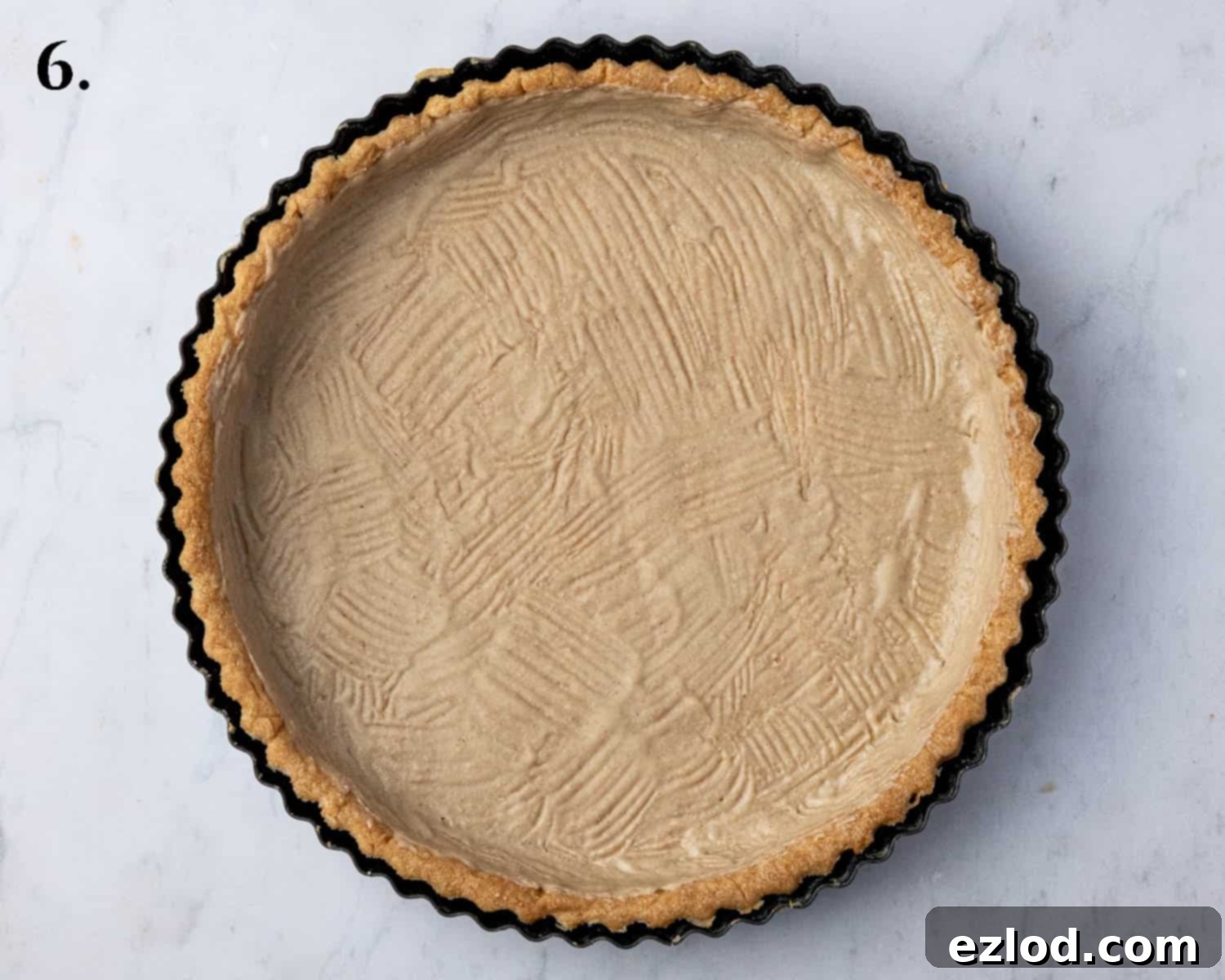
Step 7: Fill with Creamy Goodness
Take your chilled vegan pastry cream from the refrigerator. Give it a good whisk for a minute or two until it becomes wonderfully smooth and creamy again. Spoon this luscious cream into the chocolate-lined pastry case, spreading it out evenly with an offset spatula or the back of a spoon to create a flat, inviting surface.
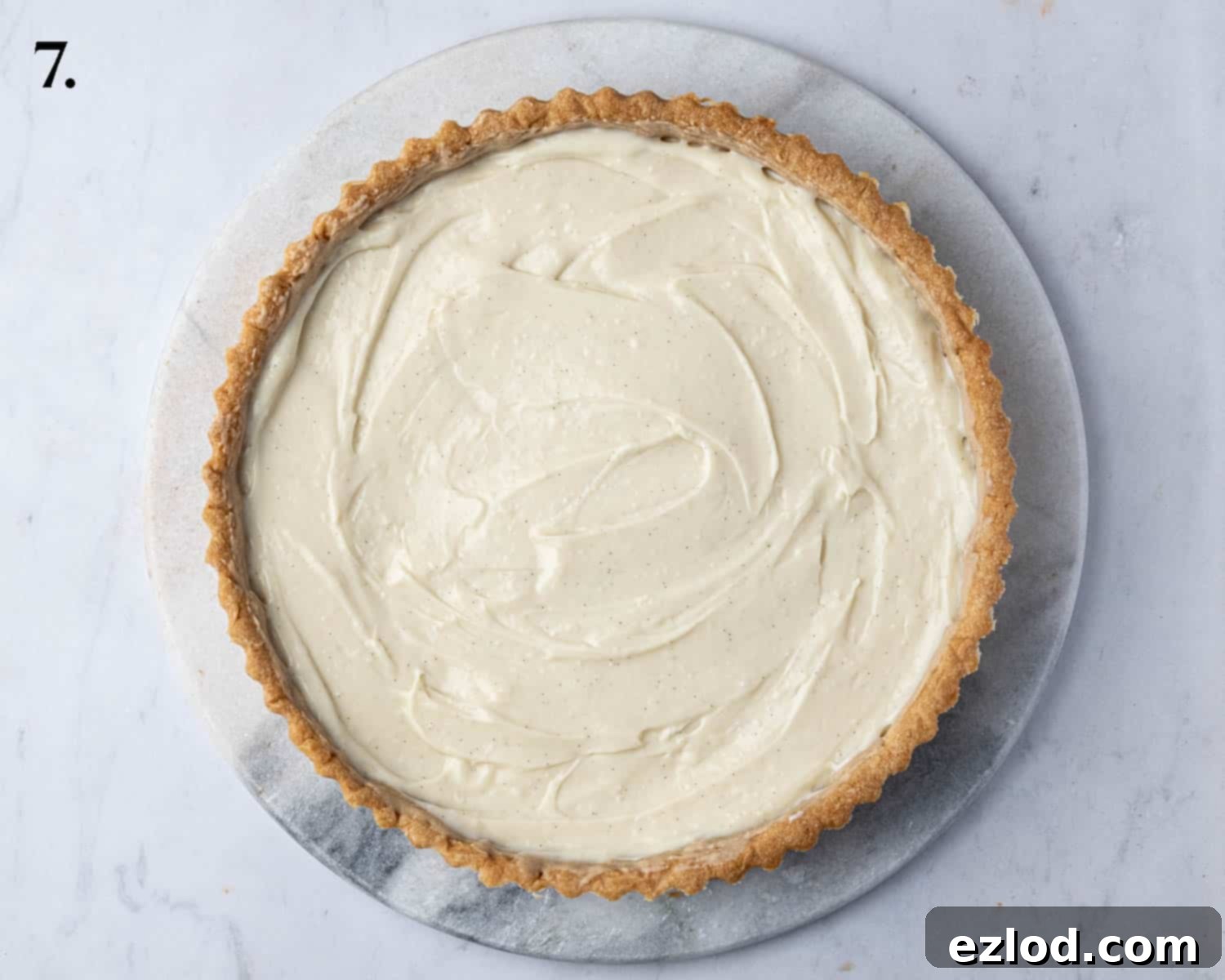
Step 8: Arrange the Rhubarb
Carefully arrange the cooled roasted rhubarb pieces on top of the pastry cream. Before placing them, gently shake off any excess juices from the rhubarb to avoid making the tart soggy. You can arrange them decoratively in a pattern or simply pile them beautifully in the center for a more rustic look. If desired, gather any leftover rhubarb juices in a small saucepan and simmer until reduced by half to create a vibrant, glossy syrup. Let it cool, then brush this syrup over the arranged rhubarb just before serving for an extra touch of flavor and shine.
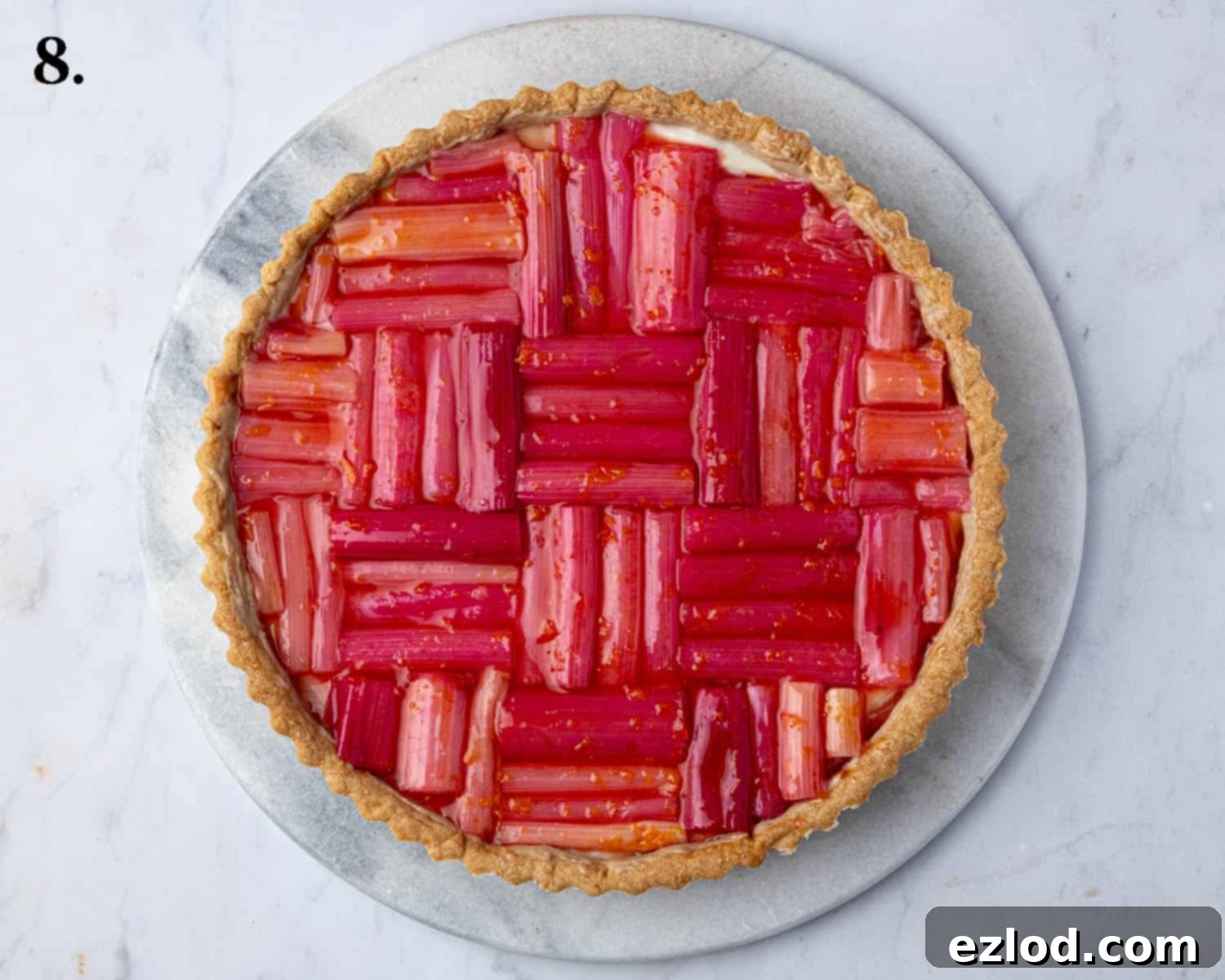
Top Tips for Vegan Rhubarb Tart Success
Achieving a perfect vegan rhubarb tart is simple with a few expert tips:
- Precision with Metrics: All my baking recipes, including this one, are developed using metric measurements (grams). I highly recommend using a digital kitchen scale for superior accuracy and consistent results. Cup conversions can be notoriously imprecise and often lead to varying outcomes in baking. A scale is also typically cleaner and easier to use!
- Chill Your Pastry Thoroughly: Do not skip the chilling steps for the pastry. Cold pastry is much easier to roll out and prevents it from becoming too soft and sticky. If your pastry becomes too firm after prolonged chilling, allow it to sit at room temperature for about 30 minutes before rolling.
- Handle Pastry Gently: For the crispiest, flakiest pastry, avoid overworking it or letting it get too warm. Over-handling can develop the gluten, resulting in a tough crust. The initial freeze before blind baking also helps maintain its shape and minimizes shrinking.
- Time-Saving Shortcut: If you’re short on time, don’t hesitate to use store-bought shortcrust pastry. Many brands are accidentally vegan – for example, most Jus-Roll pastry varieties (excluding “all-butter” versions) are vegan-friendly. Always check the ingredients label to be sure.
- Don’t Overcook the Rhubarb: Keep a close eye on the rhubarb while roasting. You want it to be tender but still firm enough to hold its shape for decorating the tart. Overcooked rhubarb will become mushy and harder to arrange beautifully.
- Ensure Pastry Cream is Cold: The vegan pastry cream must be fully chilled before assembly. This ensures it’s thick and stable enough to hold its shape in the tart.
Frequently Asked Questions (FAQs)
This vegan rhubarb tart, due to its creamy filling, must be kept refrigerated. Store it covered in the fridge, where it will remain fresh and delicious for 3-4 days. Covering it helps prevent the pastry from drying out and the rhubarb from losing its vibrancy.
No, I do not recommend freezing this tart once assembled. The pastry cream is likely to change in texture upon thawing, becoming watery or grainy, and the rhubarb might also become too soft. It’s best enjoyed fresh!
While this specific recipe uses plain flour, you can experiment with a high-quality gluten-free plain flour blend (one that includes xanthan gum) for the pastry. Be aware that gluten-free pastry can be more delicate to work with. For the pastry cream, ensure all ingredients are certified gluten-free. The overall result may vary slightly in texture.
Yes, you can use frozen rhubarb. There’s no need to thaw it beforehand. Simply place the frozen rhubarb pieces directly into the roasting tin, add the sugar, orange zest, juice, and vanilla, then roast as directed. You might need to add a few extra minutes to the roasting time, and it may release a bit more liquid, which you can drain off or reduce into a syrup.
Serving Suggestions for Your Vegan Rhubarb Tart
This exquisite vegan rhubarb tart is a showstopper all on its own, but a few thoughtful accompaniments can elevate the experience even further. Serve a slice with a dollop of homemade vegan whipped cream or a scoop of your favorite vanilla bean vegan ice cream. A light dusting of icing sugar just before serving adds a touch of elegance. Pair it with a cup of freshly brewed coffee, Earl Grey tea, or a sparkling glass of vegan prosecco for a truly decadent treat.
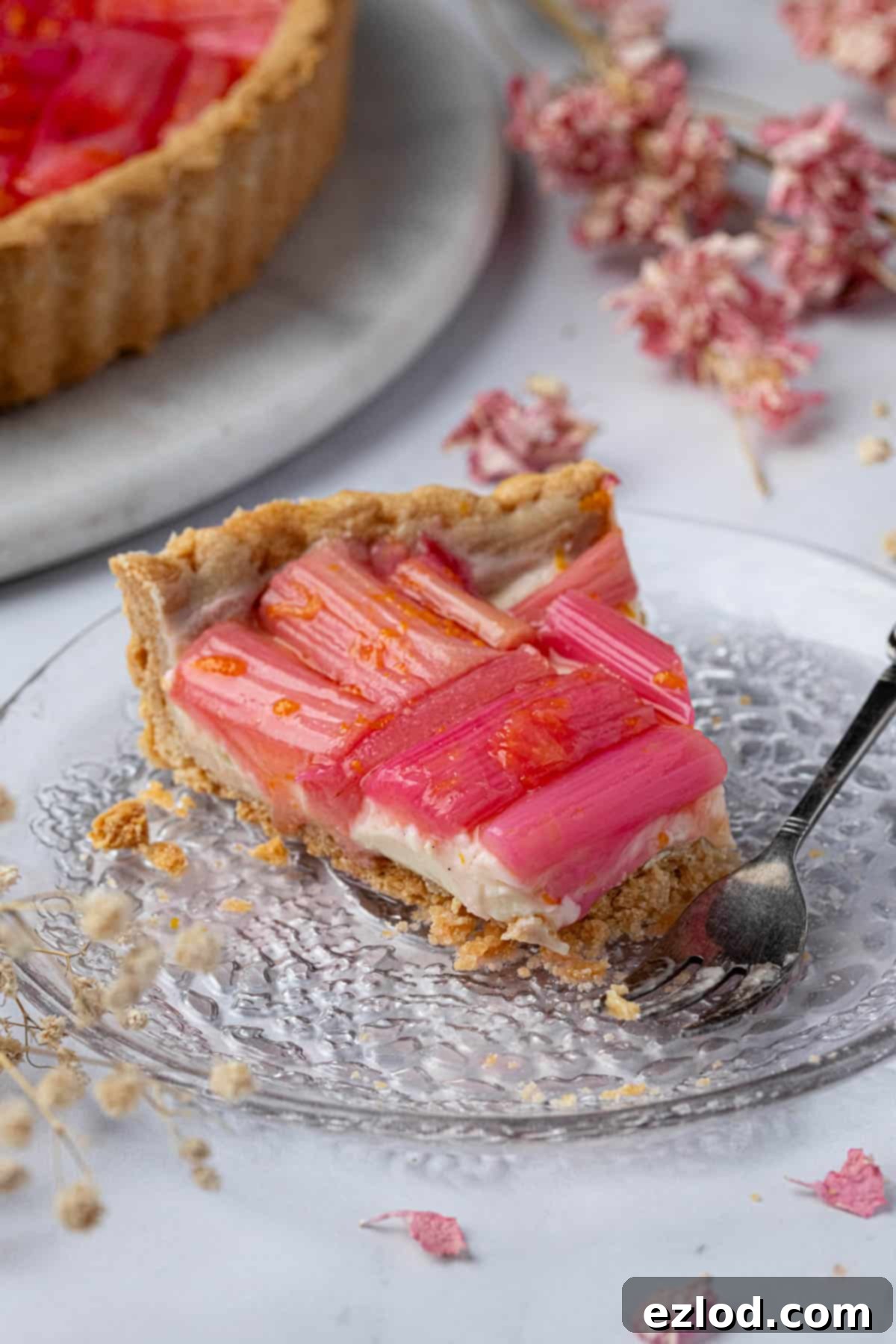
If you’ve had the pleasure of trying this delicious vegan rhubarb tart recipe, I would love to hear from you! Please take a moment to rate it, leave a comment below, or share your creation on Instagram. Don’t forget to tag @domestic_gothess and use the hashtag #domesticgothess so I can see your wonderful results!
All images and content on Domestic Gothess are copyright protected. If you wish to share this recipe, kindly do so by utilizing the provided share buttons. Please refrain from screenshotting or posting the recipe or content in its entirety; instead, include a direct link to this post for the complete recipe. Your understanding and support are greatly appreciated.

Print
Vegan Rhubarb Tart
Equipment
-
23 – 25 cm (9 – 10 in) loose bottomed tart tin
-
Roasting tin
-
Large mixing bowl
-
Rolling pin
-
Baking parchment
-
Baking beans or dried rice
-
Pastry brush (optional)
Ingredients
For the Pastry:
- 200 g (1 + ⅔ cup) plain (all-purpose) flour
- 50 g (½ cup) ground almonds
- 30 g (⅓ cup) icing (powdered) sugar
- ¼ teaspoon salt
- 130 g (½ cup + 1 Tablespoon) vegan block butter cold and diced
- 1 Tablespoon cold vodka (or water)
- 1-2 Tablespoons of extra cold water, if needed
For the Rhubarb:
- 400 g (14 oz) forced rhubarb cut into 5cm (2-inch) pieces
- 60 g (heaped ¼ cup) caster or granulated sugar
- finely grated zest and juice of 1 large orange
- 1 teaspoon vanilla extract
To Assemble:
- 75 g (2 ½ oz) vegan white chocolate melted, for brushing the pastry shell
- 1 batch vegan pastry cream chilled (recipe link above)
Instructions
-
Begin by preparing your vegan pastry cream well in advance. It needs ample time to chill and set properly in the refrigerator before you start on the tart, ideally several hours or overnight.
-
To make the shortcrust pastry, combine the plain flour, ground almonds, icing sugar, and salt in a large bowl. Whisk these dry ingredients together thoroughly to ensure they are well mixed.
-
Add the very cold, cubed vegan block butter to the flour mixture. Using your fingertips, rub the butter into the dry ingredients until the mixture resembles fine breadcrumbs. It’s important to work quickly to keep the butter cold and prevent it from melting. No large lumps of butter should remain.
-
Pour in the cold vodka (if using) and mix briefly to combine. Then, gradually add cold water, starting with 1 tablespoon and adding more a teaspoon at a time, until the pastry just comes together into a soft, pliable ball. Avoid kneading; simply bring the dough together. Shape the pastry into a disc, wrap it tightly in plastic wrap, and refrigerate for at least one hour (or up to 2 days) until it is firm and easy to roll.
-
On a lightly floured surface, roll out the chilled pastry into a circular shape, roughly 2-3mm thick, and large enough to line a 23-25 cm (9-10 inch) loose-bottomed tart tin. Carefully transfer the pastry to the tin, gently pressing it into the fluted edges and corners without stretching it. Trim off any excess pastry from the top edge.
-
Prick the base of the pastry shell all over with a fork to prevent air bubbles during baking. Place the entire tart tin with the pastry shell into the freezer for 20 minutes to firm up completely. While it’s freezing, preheat your oven to 180°C (160°C fan/350°F/Gas Mark 4).
-
Remove the frozen pastry case from the freezer. Line it with a piece of baking parchment, ensuring it covers the base and extends up the sides. Fill the lined shell generously with baking beans or dried rice, distributing the weight evenly to support the pastry walls during baking.
-
Bake the pastry case (with weights) for 25 minutes. Then, carefully remove the baking parchment and baking beans. Return the tart shell to the oven for a further 15-20 minutes, or until it is beautifully golden brown and completely dry. Set the baked pastry shell aside on a wire rack to cool down completely.
-
While the pastry cools, prepare the rhubarb. Slice the rhubarb into uniform 5cm (2-inch) pieces. Lay them in a single layer in a shallow roasting tin. Sprinkle over the caster or granulated sugar, orange zest, and pour over the orange juice and vanilla extract. Gently toss to coat.
-
Roast the rhubarb in the preheated oven for 12-15 minutes. It should be tender when pierced with a knife but still holding its shape and not mushy. This ensures it looks beautiful when arranged on the tart. Remove from the oven and allow it to cool completely in the roasting tin.
-
Once the pastry case is entirely cool, melt the vegan white chocolate (you can do this gently in a microwave or over a double boiler). Using a clean pastry brush, brush a thin, even layer of melted white chocolate over the entire inside surface of the cooled pastry case. This creates a protective barrier against moisture. Allow the chocolate to set completely before proceeding – you can place it in the fridge for a few minutes to speed this up.
-
Retrieve the chilled vegan pastry cream from the fridge. Give it a vigorous whisk until it becomes smooth, creamy, and spreadable again. Spoon the pastry cream into the chocolate-lined pastry case, spreading it out evenly with an offset spatula or the back of a spoon to create a level surface.
-
Carefully arrange the cooled roasted rhubarb pieces on top of the pastry cream. Before placing each piece, gently shake off any excess juices from the rhubarb to prevent the tart from becoming soggy. You can create a beautiful pattern or simply pile them artistically.
-
For an extra touch, gather any leftover rhubarb juices from the roasting tin and pour them into a small saucepan. Simmer gently over medium heat until the liquid has reduced by half and thickened slightly into a syrup. Let this syrup cool completely, then lightly brush it over the arranged rhubarb on the tart just before serving for added shine and intensified flavor. Keep the finished tart refrigerated until ready to serve.
Notes
- For detailed tips, ingredient insights, and step-by-step photos to guide you through the process, please refer to the main article above the recipe card.
- For accurate and consistent baking results, I strongly recommend using metric measurements with a digital kitchen scale for all my recipes. Cup measurements can be quite imprecise and lead to variations in your final product.
- Be mindful not to overcook the rhubarb during the roasting stage. It should be tender but still hold its shape, making it easier and more appealing to arrange on top of the tart.
- Remember that the vegan pastry cream needs to be prepared and thoroughly chilled beforehand for optimal setting and texture in the tart.
- If you find your pastry too firm after chilling, let it sit at room temperature for about 30 minutes before rolling to make it more pliable.
